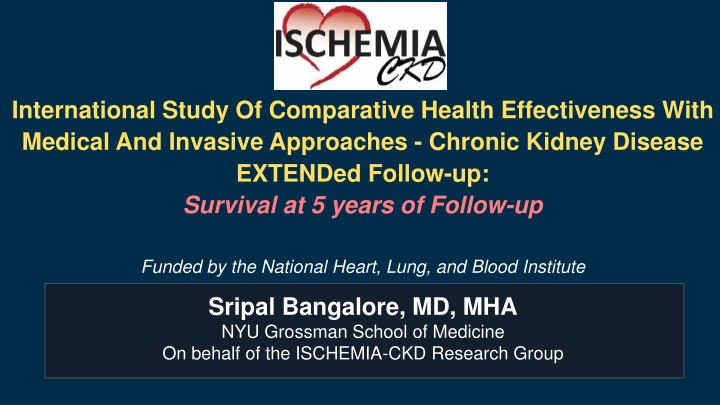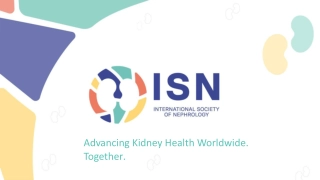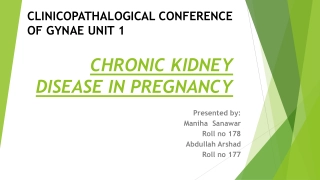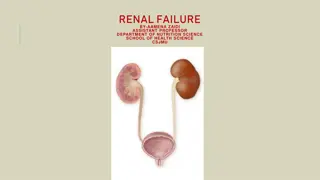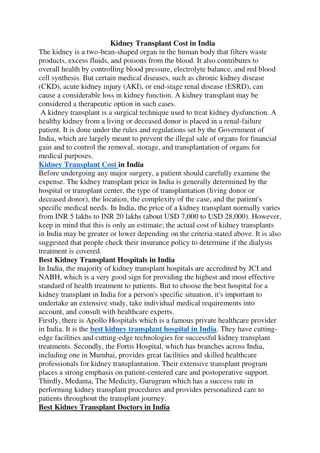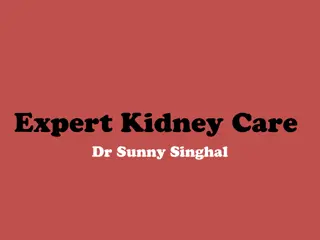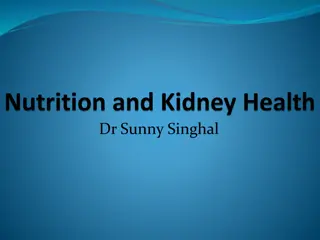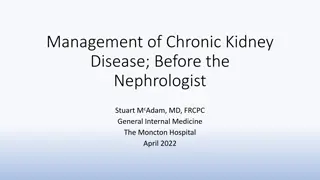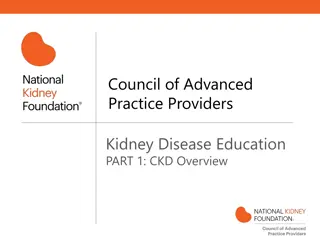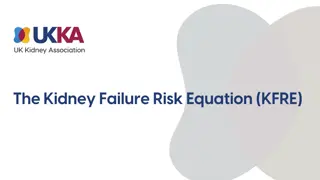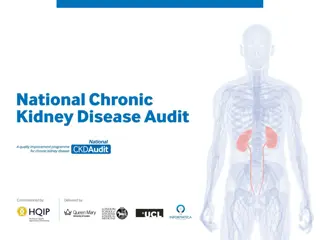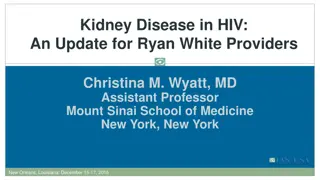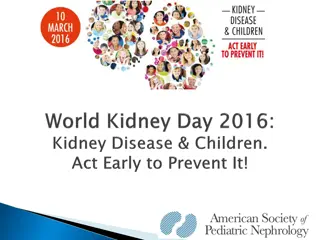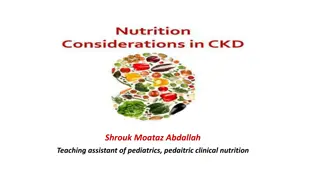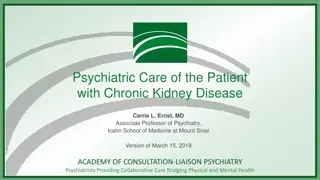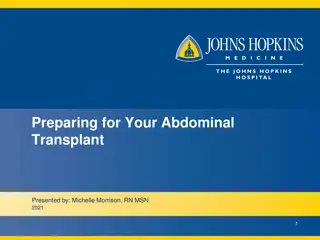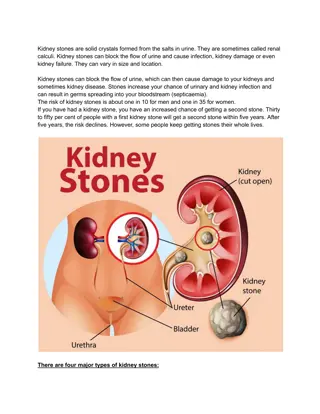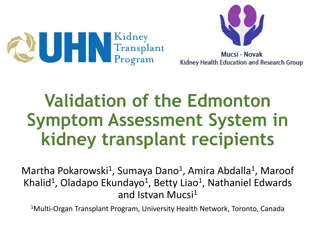Comparative Study on Health Effectiveness in Chronic Kidney Disease
Study focuses on the benefits of adding cardiac catheterization and revascularization to medical therapy in stable CKD patients with moderate ischemia. The ISCHEMIA-CKD trial compared invasive versus conservative treatment strategies, enrolling high-risk patients with various comorbidities. Results indicated a larger percentage of patients opted for an invasive approach, with promising results at the 3-year mark.
Download Presentation

Please find below an Image/Link to download the presentation.
The content on the website is provided AS IS for your information and personal use only. It may not be sold, licensed, or shared on other websites without obtaining consent from the author.If you encounter any issues during the download, it is possible that the publisher has removed the file from their server.
You are allowed to download the files provided on this website for personal or commercial use, subject to the condition that they are used lawfully. All files are the property of their respective owners.
The content on the website is provided AS IS for your information and personal use only. It may not be sold, licensed, or shared on other websites without obtaining consent from the author.
E N D
Presentation Transcript
International Study Of Comparative Health Effectiveness With Medical And Invasive Approaches - Chronic Kidney Disease EXTENDed Follow-up: Survival at 5 years of Follow-up Funded by the National Heart, Lung, and Blood Institute Sripal Bangalore, MD, MHA NYU Grossman School of Medicine On behalf of the ISCHEMIA-CKD Research Group
Disclosure Statement of Financial Interest Grant support: NHLBI Advisory board- Abbott Vascular, Biotronik, Boston Scientific, Amgen, Pfizer, Merck, Inari, Reata
ISCHEMIA-CKD EXTEND Research Question In stable patients with advanced CKD and at least moderate ischemia on a stress test, is there a long-term benefit to adding cardiac catheterization and, if feasible, revascularization to optimal medical therapy?
CKD Patients are Under-Represented in Contemporary Revascularization vs. Medicine SIHD Trials 2007 2009 2012 FAME 2 FAME 2 Trial Trial Subjects with serum Cr >2 mg/dl excluded Serum Cr >2 mg/dl: 20 subjects eGFR <30: 16 Subjects
ISCHEMIA-CKD Study Design Patients with moderate or severe ischemia and eGFR <30 or on dialysis RANDOMIZE 1:1 Randomized Trial Phase INVASIVE Strategy Optimal Medical Therapy + Cath + Optimal Revascularization (if suitable) CONSERVATIVE Strategy Optimal Medical Therapy alone Cath and revascularization (if suitable) reserved for Optimal Medical Therapy failure Primary Endpoint: Composite of Death or MI Extended Follow- Up Phase Endpoints: All-cause Death; Cardiovascular Death
ISCHEMIA-CKD Trial: Summary 777 patients (2014 to 2018) randomized to INV vs. CON Largest treatment strategy trial of SIHD and advanced CKD Enrolled high-risk subset Median age 63 years; 57% diabetes; 53% on dialysis; 38% severe ischemia; 51% multivessel CAD; 57% LAD disease Cath and Revascularization Invasive strategy: 85% cath; 50% revascularized (85% PCI/15% CABG) Conservative strategy: 32% cath; 20% revasc at 3-years Medication Therapy 85% statins; 43% high-intensity statin; LDL 70 mg/dl; SBP 130 mm Hg Bangalore et al. NEJM. 2020
Background: ISCHEMIA-CKD Primary Outcome Death or MI Median follow-up of 2.2 years Bangalore et al. NEJM. 2020
Background: ISCHEMIA-CKD Secondary Outcomes Median follow-up of 2.2 years Bangalore et al. NEJM. 2020
Background: ISCHEMIA-CKD Secondary Outcome Myocardial Infarction types Median follow-up of 2.2 years Procedural MI Spontaneous MI Bangalore et al. NEJM. 2020
ISCHEMIA EXTEND Study Design ISCHEMIA EXTEND 37 countries; 164 sites* Centralized Vital Status Registry (Annual) 33% participants Participant Contact** (Biannual) 67% participants 34 countries 3 countries *Participation status of some sites in China is pending. **Direct participant contact may be supplemented with healthcare record/registry searches.
ISCHEMIA-CKD EXTEND Study Timeline Median 5 years follow-up 1st pt enrolled AHA LBCT 2014 2019 2026 2018 Last pt enrolled 2022 ESC LBCT Median ~9 years follow-up Median 2.2 years follow-up
ISCHEMIA-CKD EXTEND Outcomes All-cause death Cardiovascular death
ISCHEMIA-CKD EXTEND Statistical Considerations Cox proportional hazard regression model adjusting for age, sex, diabetes, LVEF, dialysis status and baseline eGFR (in patients not on dialysis) Bayesian piecewise exponential survival model with minimally informative priors
ISCHEMIA-CKD EXTEND- 5 Years All-Cause Death 60 50 P-value= 0.338 (log rank) Invasive Cumulative Incidence (%) HRadj=1.12 (0.89, 1.41); P-value= 0.322 40.6% 40 37.4% 30 Conservative 20 10 0 0 1 2 3 4 5 Years Since Randomization 316 312 No. at Risk Conservative 389 Invasive 351 350 289 277 264 247 136 112 388
ISCHEMIA-CKD EXTEND- 5 Years All-Cause Death (Bayesian Analysis) Mean difference (3.0%) 0.12 >1% reduction with CON Probability (74%) 0.08 density >1% reduction with INV Probability (11%) 0.04 0.00 -10 16 10 12 14 -8 -6 -4 INV vs. CON at 5 Years (%) -2 2 0 4 6 8
ISCHEMIA-CKD EXTEND- 5 Years All-Cause Death: Heterogeneity of Treatment Effect
ISCHEMIA-CKD EXTEND- 5 Years Cardiovascular Death 60 P-value= 0.687 (Fine gray) HRadj=1.04 (0.80, 1.37); P-value= 0.753 50 Cumulative Incidence (%) 40 Invasive 29.0% 30 27.1% 20 Conservative 10 0 0 1 2 3 4 5 Years Since Randomization No. at Risk Conservative 389 Invasive 351 350 316 312 289 277 264 247 136 112 388
ISCHEMIA-CKD EXTEND- 5 Years Cardiovascular Death (Bayesian Analysis) Mean difference (0.8%) >1% reduction with CON >1% reduction with INV Probability (47.6%) Probability (27.9%) 0.10 density 0.05 0.00 -10 10 12 -8 -6 -4 INV vs. CON at 5 Years (%) -2 0 2 4 6 8
ISCHEMIA-CKD EXTEND- 5 Years Cardiovascular Death: Heterogeneity of Treatment Effect
Study Limitations Low rates of revascularization in the invasive arm driven by high rates of non obstructive CAD due to randomization prior to coronary angiography Based on exclusion criteria, the trial results do not apply to patients with: Acute coronary syndromes within previous 2 months Highly symptomatic patients LVEF <35%
Conclusions At 5-years, patients randomized in ISCHEMIA-CKD High rates of death (~39%) High rate of CV death (~28%) An initial invasive strategy and an initial conservative strategy resulted in similar survival at a median of 5-years follow-up
